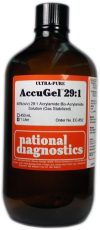Electrophoresis
AccuGel 29:1 (40%)
$98.00 – $174.00
Quantity discount when you buy 4 or more 1 liter bottles!
Catalog number: EC-852
- 29:1 Acrylamide to Bisacrylamide Stabilized Solution
- Consistently Crystal Clear Gels
- Aldehyde and Acrylic Acid Free
- Certified RNase and DNase Free
- Stabilized for Long Shelf Life
- Formulated with 18 MegOhm Water, 0.2 Micron Filtration
Description
Quantity discount when you buy 4 or more 1 liter bottles!
Catalog number: EC-852
- 29:1 Acrylamide to Bisacrylamide Stabilized Solution
- Consistently Crystal Clear Gels
- Aldehyde and Acrylic Acid Free
- Certified RNase and DNase Free
- Stabilized for Long Shelf Life
- Formulated with 18 MegOhm Water, 0.2 Micron Filtration
Reliable
AccuGel 29:1 is a stabilized, ready-to-use solution of 40% (w/v) acrylamide : bisacrylamide(29:1). AccuGel 29:1 has zero acrylic acid content, eliminating the fixed charges that cause band streaking. Additionally, oxidation products such as aldehydes have been removed by a selective adsorption process. With AccuGel 29:1, you can trust that your results will be consistent from one electrophoretic run to the next.
Improved Safety
AccuGel 29:1 reduces exposure to neurotoxic acrylamide dust by eliminating the need for handling and weighing solid acrylamide and methylene bisacrylamide, which often leads to airborne particulate that can be readily inhaled. For your protection, AccuGel 29:1 is supplied in PVC coated shatter-proof bottles.
Stable and Pure
AccuGel 29:1 is stable for 24 months when stored tightly capped in a dark area at room temperature.
Additional information
| Weight | 4.7 lbs |
|---|---|
| Dimensions | 7 × 7 × 14 in |
Protocol
Procedure
Mix Gel Solution
Calculate how much AccuGel you need to make your gels by using the formulas below. Bring up to the desired final volume with your usual buffers and distilled water. Pour the solution into an Erlenmeyer flask with a side-arm. In most cases, AccuGel will gel without degassing. However, for optimum reproducibility, add a stirring bar to the solution and stopper the flask. Degas the solution under a vacuum for 5 minutes while stirring on a magnetic stirrer.
or
VA40 =(X) (Vt)/40 for 40% AccuGel
where:
Vt = Total volume of gel casting (solution desired (ml))
VA30 = Volume of 30% AccuGel to be used (ml)
OR
VA40 = Volume of 40% AccuGel to be used (ml)
Initiate and Cast Gel:
Add 1.0ml of 10% (w/v) FRESHLY PREPARED ammonium persulfate for every 100ml of gel casting solution. Swirl gently to mix. Add 100 microliters of TEMED for every 100ml of gel casting solution. Swirl gently to mix. Pour the solution into the gel casting cassette. The gel should begin to set in 10-20 minutes. Polymerization should be permitted to continue for a minimum of 1.5-2 hours before gel is run.
NOTE: After two hours of polymerization wrap each end of the gel cassette with clear plastic wrap. This is important to keep the ends of the gel from drying and to maintain sample well integrity. Appropriately wrapped gels may be stored for up to 48 hours.
Safety Overview
Safety Summary (see SDS for complete information before using product):
EMERGENCY OVERVIEW – IMMEDIATE HAZARD
WARNING! NEUROTOXIN. HARMFUL IF SWALLOWED, INHALED OR ABSORBED THROUGH SKIN. SYMPTOMS OF EXPOSURE MAY INCLUDE NUMBNESS, SWEATING OR ALTERED GAIT. MAY CAUSE ALLERGIC SKIN REACTION. MAY CAUSE EYE IRRITATION. POLYMERIZATION MAY OCCUR FROM EXCESSIVE HEAT OR CONTAMINATION.
- UV Shadowing
- Using PAGE to Determine Nucleic Acid Molecular Weight
- Uneven Staining
- The Polyacrylamide Matrix-Buffer Strength
- The Polyacrylamide Matrix
- The Mechanical and Electrical Dynamics of Gel Electrophoresis — Electrophoresis System Dynamics
- The Mechanical and Electrical Dynamics of Gel Electrophoresis – Ohm’s Law
- The Mechanical and Electrical Dynamics of Gel Electrophoresis – Intro and Sample Mobility
- The Electrophoresis Matrix
- The Agarose Matrix
- Staining Proteins Immobilized on Membranes
- Staining Protein Gels with Coomassie Blue
- SSCP Analysis
- Southern Blotting
- Smeared Bands
- Silver Staining Protein Gels
- Silver Staining DNA Gels
- Sanger Sequencing
- Sample Preparation for SDS-PAGE
- Sample Preparation for Native Protein Electrophoresis
- Sample Preparation for Native PAGE of DNA
- Sample Prep for Denaturing PAGE of DNA
- S1 Mapping
- Run Conditions in Denaturing PAGE
- RNA Mapping
- RNA Electrophoresis
- Ribonuclease Protection
- Restriction Digest Mapping
- Radioactive Emissions and the Use of Isotopes in Research
- Protein Fixation on Gels
- Primer Extension
- Preparing Denaturing DNA & RNA Gels
- Preparation of Denaturing Agarose Gels
- Preparation of Agarose Gels
- Pouring Sequencing Gels
- Post-Electrophoretic Visualization with Nuclistain
- PFGE and FIGE
- Peptide Mapping
- PCR Analysis: Yield and Kinetics
- PCR Analysis: An Examination
- Overview of Western Blotting
- Northern Blotting
- Native Protein Electrophoresis
- Native PAGE of DNA
- Multiphasic Buffer Systems
- Mobility Shift Assay
- Methylation & Uracil Interference Assays
- Method for Western Blotting
- Mechanism of Immunostaining
- Mechanism of Immunostaining
- Measuring Molecular Weight with SDS-PAGE
- Maxam & Gilbert Sequencing
- Manual Sequencing
- Isotachophoresis
- Isoelectric Focusing
- In Gel Enzyme Reactions
- Immunostaining with Alkaline Phosphatase
- Immuno-Electrophoresis / Immuno-Diffusion
- Horizontal and Vertical Gel Systems – Vertical Tube Gels
- Horizontal and Vertical Gel Systems – The Vertical Slab Gel System
- Horizontal and Vertical Gel Systems – The Horizontal Gel System
- Homogeneous Buffer Systems
- Heteroduplex Analysis
- Guide Strip Technique
- Gel Preparation for Native Protein Electrophoresis
- Gel Preparation for Native PAGE of DNA
- Gel Electrophoresis of RNA & Post Electrophoretic Analysis
- Gel Electrophoresis of PCR Products
- Faint bands, low background
- Faint Bands, High Background
- Ethidium Bromide Staining
- Enzyme Linked Immunosorbent Assay (ELISA)
- Electrophoresis Buffers-Choosing the Right Buffer
- Electrophoresis Buffers–The Henderson-Hasselbalch Equation
- DNase I Footprinting
- DNA/RNA Purification from PAGE Gels
- DNA/RNA Purification from Agarose Gels – Electroelution
- Differential Display
- Denaturing Protein Electrophoresis: SDS-PAGE
- Denaturing Polyacrylamide Gel Electrophoresis of DNA & RNA
- Coomassie Blue Stain- Troubleshooting
- Conformational Analysis
- Casting Gradient Gels
- Buffer Additives-Surfactants
- Buffer Additives-Reducing Agents
- Buffer Additives-Hydrogen Bonding Agents
- Blotches on Gel
- Biological Macromolecules: Nucleic Acids
- Biological Macromolecules – Proteins
- Autoradiography
- Autoradiographic Enhancement with Autofluor
- Automated Sequencers
- Analysis of DNA/Protein Interactions
- An Overview of Northern and Southern Blotting
- Alkaline Blotting
- Agarose Gel Electrophoresis of DNA and RNA – Uses and Variations
- Agarose Gel Electrophoresis of DNA and RNA – An Introduction
- Activity Stains




